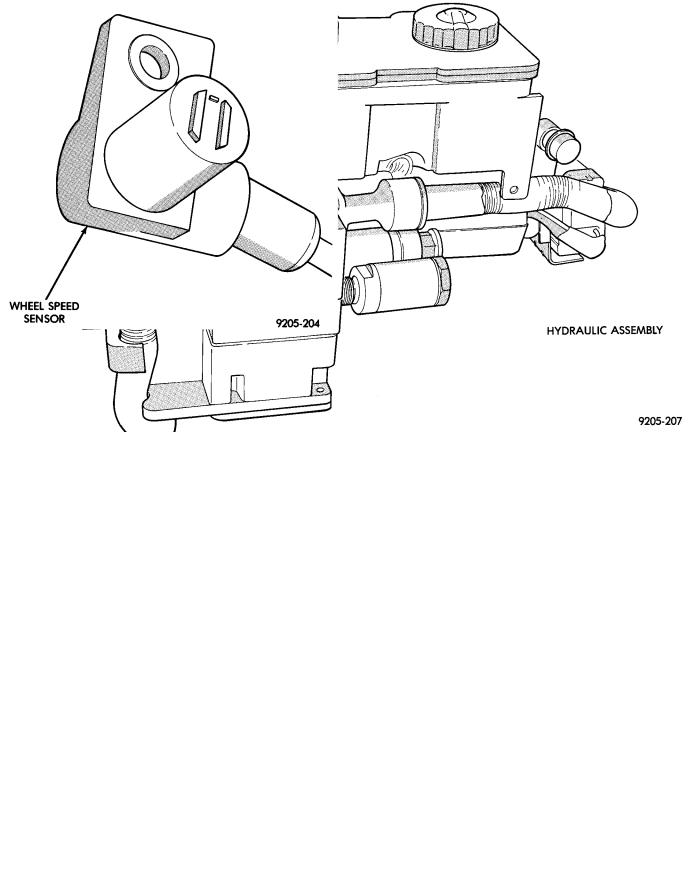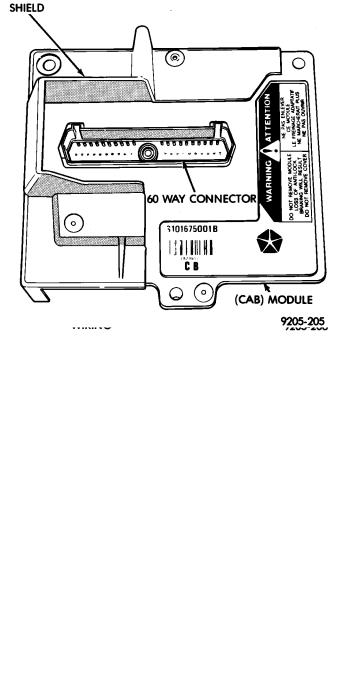
- •GENERAL INFORMATION
- •SERVICE ADJUSTMENTS
- •MASTER CYLINDER FLUID LEVEL
- •ABS BRAKES
- •ADJUSTING REAR SERVICE BRAKES
- •TESTING APPLICATION ADJUSTER OPERATION
- •BLEEDING BRAKE SYSTEM
- •PRESSURE BLEEDING
- •BLEEDING WITHOUT A PRESSURE BLEEDER
- •TEST FOR FLUID CONTAMINATION
- •WHEEL STUD NUT TIGHTENING
- •BRAKE HOSE AND TUBING
- •INSPECTION OF BRAKE HOSE AND TUBING
- •FIG. 10 BRAKE LINE ROUTING NON ABS BRAKES
- •INSTALLATION OF BRAKE HOSE
- •TYPES OF TUBING FLARES
- •TO REPAIR OR FLARE TUBING
- •ISO TUBING FLARES
- •BASIC DIAGNOSIS GUIDE
- •BRAKE SYSTEM DIAGNOSTICS
- •BRAKE SYSTEM DIAGNOSTICS
- •BRAKE SYSTEM DIAGNOSTICS
- •BRAKE SYSTEM DIAGNOSTICS
- •REAR WHEEL DRUM BRAKES
- •DESCRIPTION
- •SERVICE PROCEDURES
- •REAR BRAKE DRUM REMOVAL
- •BRAKE DRUM INSTALLATION
- •BRAKE SHOE ASSEMBLIES
- •REMOVAL
- •CLEANING AND INSPECTION
- •BRAKE SHOE INSTALLATION
- •KELSEY HAYES REASSEMBLE
- •VARGA REASSEMBLE
- •BRAKE DRUM REFACING
- •WHEEL CYLINDERS
- •GENERAL INFORMATION
- •SERVICE PROCEDURES
- •REMOVING WHEEL CYLINDERS FROM BRAKE SUPPORT PLATES
- •DISASSEMBLING WHEEL CYLINDERS
- •ASSEMBLING WHEEL CYLINDERS
- •INSTALLING WHEEL CYLINDERS
- •BRAKE SUPPORT ASSEMBLY
- •REMOVAL
- •INSTALLATION
- •HYDRAULIC SYSTEM CONTROL VALVES
- •GENERAL INFORMATION
- •PRESSURE DIFFERENTIAL WARNING LIGHT SWITCH
- •ABS BRAKE PROPORTIONING VALVE OPERATION
- •HYDRAULIC SYSTEM SERVICE PROCEDURES
- •BRAKE WARNING SYSTEM
- •PROPORTIONING VALVES
- •PROPORTIONING VALVE APPLICATIONS
- •TESTING ABS PROPORTIONING VALVES
- •FRONT DISC BRAKES
- •GENERAL INFORMATION
- •SHOE AND LINING WEAR
- •SERVICE PRECAUTIONS
- •KELSEY HAYES DOUBLE PIN FAMILY CALIPER
- •BRAKE SHOE SERVICE PROCEDURES
- •REMOVAL
- •INSTALLATION
- •SERVICE PROCEDURES
- •BRAKE SHOES REMOVE
- •CLEANING AND INSPECTION
- •BRAKE SHOES INSTALL
- •DISC BRAKE CALIPER DISASSEMBLY
- •CLEANING AND INSPECTION
- •CLEANING AND INSPECTION OF BRAKE CALIPER
- •ASSEMBLING DISC BRAKE CALIPER
- •REAR DISC BRAKES
- •GENERAL INFORMATION
- •LINING WEAR
- •SERVICE PRECAUTIONS
- •BRAKE SHOE REMOVAL
- •CLEANING AND INSPECTION
- •BRAKE SHOE INSTALLATION
- •DISASSEMBLING REAR CALIPER ASSEMBLY
- •CLEANING AND INSPECTION
- •CLEANING AND INSPECTION
- •ASSEMBLING REAR DISC BRAKE CALIPER
- •BRAKE DISC (ROTOR)
- •GENERAL INFORMATION
- •INSPECTION DIAGNOSIS
- •SERVICE PROCEDURES
- •CHECKING BRAKING DISC FOR RUNOUT AND THICKNESS
- •BRAKING DISC REMOVAL
- •INSTALLING BRAKING DISC
- •REFINISHING BRAKING DISC
- •REFACING BRAKING DISC
- •RESURFACING BRAKING DISC
- •BRAKING DISC (ROTOR) REFINISHING LIMITS
- •PARKING BRAKES
- •GENERAL INFORMATION
- •SERVICE PROCEDURES
- •ADJUSTING PARKING BRAKE
- •FIG. 2 PARKING BRAKE CABLE ROUTING AA AND AP BODY
- •FIG. 4 PARKING BRAKE CABLE ROUTING AG AND AJ BODY
- •SELF ADJUSTING PROCEDURES
- •TO RELOAD SELF ADJUSTER
- •ADJUST PARKING BRAKE
- •REAR PARKING BRAKE CABLE REMOVAL
- •DRUM BRAKES
- •DISC BRAKES
- •INSTALLING PARKING BRAKE REAR CABLE
- •DRUM BRAKES
- •DISC BRAKES ALL
- •REMOVING PARKING BRAKE FRONT CABLE
- •INSTALLING PARKING BRAKE FRONT CABLE
- •REMOVAL AG AND AJ BODY
- •INSTALLATION AG AND AJ BODY
- •REMOVAL AND INSTALLATION PARKING BRAKE SHOES
- •ALL WITH REAR DISC BRAKES
- •INSTALLING PARKING BRAKE SHOES
- •MASTER CYLINDER
- •GENERAL INFORMATION
- •BRAKE FLUID LEVEL SENSOR
- •TESTING THE MASTER CYLINDER
- •MASTER CYLINDER SERVICE PROCEDURES
- •MASTER CYLINDER REMOVAL
- •BRAKE FLUID RESERVOIR REPLACEMENT
- •BLEEDING MASTER CYLINDER
- •INSTALLING MASTER CYLINDER
- •POWER BRAKES
- •GENERAL INFORMATION
- •SERVICE PROCEDURES
- •POWER BRAKE BOOSTER ASSEMBLY
- •WHEEL BEARINGS
- •FRONT WHEEL BEARINGS
- •REAR WHEEL BEARINGS
- •NORMAL SERVICE
- •INSPECTION
- •REMOVAL AND INSTALLATION
- •GENERAL INFORMATION
- •NORMAL BRAKING SYSTEM FUNCTION
- •MAJOR ABS COMPONENTS
- •HYDRAULIC ASSEMBLY
- •WHEEL SPEED SENSORS
- •NORMAL BRAKING SYSTEM FUNCTION
- •PEDAL FEEL
- •TIRE NOISE & MARKS
- •ABS EQUIPPED VEHICLE PERFORMANCE
- •ABS WARNING SYSTEMS OPERATION
- •RED BRAKE WARNING LAMP
- •NORMAL OPERATION OF WARNING LAMPS
- •HYDRAULIC ASSEMBLY
- •HYDRAULIC BLADDER ACCUMULATOR
- •DUAL FUNCTION PRESSURE SWITCH
- •PRESSURE TRANSDUCERS
- •DIFFERENTIAL PRESSURE SWITCH
- •PROPORTIONING VALVES
- •FLUID LEVEL SWITCH
- •DUAL FUNCTION PRESSURE SWITCH WIRING DIAGRAM
- •WHEEL SPEED SENSORS
- •PRESSURE SWITCH AND PRESSURE TRANSDUCER WIRING
- •ABS SYSTEM WIRING SCHEMATIC
- •ABS SYSTEM DIAGNOSTIC CONNECTOR
- •SYSTEM RELAY
- •ABS HYDRAULIC CIRCUITS AND VALVE OPERATION
- •NORMAL BRAKING
- •ABS BRAKING SYSTEM DIAGNOSIS
- •GENERAL INFORMATION
- •DEFINITIONS
- •ABS SYSTEM GENERAL SERVICE PRECAUTIONS
- •TEST DRIVING ABS COMPLAINT VEHICLES
- •WHEEL SPEED SENSOR CABLES
- •SPECIAL SERVICE TOOLS
- •INTERMITTENT FAULTS
- •ABS BRAKE SYSTEM DIAGNOSTIC FEATURES
- •SYSTEM SELF DIAGNOSIS
- •BENDIX ABS SYSTEMS DIAGNOSTICS
- •ON CAR HYDRAULIC ABS COMPONENT SERVICE
- •GENERAL SERVICE PRECAUTIONS
- •CHECKING BRAKE FLUID LEVEL
- •BLEEDING ABS BRAKE SYSTEM
- •BRAKE FLUID PRESSURE AND RETURN HOSES (FIG. 6)
- •INSTALL
- •HYDRAULIC ASSEMBLY
- •BRAKE FLUID RESERVOIR
- •HYDRAULIC BLADDER ACCUMULATOR
- •PROPORTIONING VALVES (FIG. 17)
- •ELECTRONIC COMPONENTS
- •WHEEL SPEED SENSORS
- •FRONT WHEEL SPEED SENSOR
- •REAR WHEEL SPEED SENSOR (FIGS. 13 AND 15)
- •GENERAL INFORMATION
- •NORMAL BRAKING SYSTEM FUNCTION
- •MAJOR COMPONENTS
- •MASTER CYLINDER AND VACUUM BOOSTER
- •WHEEL SPEED SENSORS
- •PEDAL FEEL
- •TIRE NOISE & MARKS
- •VEHICLE PERFORMANCE
- •WARNING SYSTEMS OPERATION
- •NORMAL OPERATION OF WARNING LAMP
- •MODULATOR ASSEMBLY
- •ISOLATION VALVES
- •SHUTTLE ORIFICE
- •FLUID SUMPS
- •HYDRAULIC SPRING ACCUMULATOR
- •PROPORTIONING VALVES
- •WHEEL SPEED SENSORS
- •DIAGNOSTIC CONNECTOR
- •SYSTEM RELAY
- •HYDRAULIC CIRCUITS AND VALVE OPERATION
- •NORMAL BRAKING
- •ABS BRAKE SYSTEM DIAGNOSIS
- •GENERAL INFORMATION
- •DEFINITIONS
- •ABS COMPUTER SYSTEM SERVICE PRECAUTIONS
- •ABS GENERAL SERVICE PRECAUTIONS
- •TEST DRIVING ABS COMPLAINT VEHICLES
- •ABS BRAKE SYSTEM ON VEHICLE SERVICE
- •WHEEL SPEED SENSOR CABLES
- •SPECIAL SERVICE TOOL
- •INTERMITTENT FAULTS
- •ABS BRAKE SYSTEM DIAGNOSTIC FEATURES
- •ABS SYSTEM SELF DIAGNOSIS
- •BENDIX ABS SYSTEMS DIAGNOSTICS
- •GENERAL SERVICE PRECAUTIONS
- •CHECKING BRAKE FLUID LEVEL
- •MODULATOR ASSEMBLY (FIG. 2)
- •MASTER CYLINDER AND POWER BOOSTER
- •PROPORTIONING VALVES (FIG. 5)
- •ELECTRONIC COMPONENTS
- •WHEEL SPEED SENSORS
- •FRONT WHEEL SPEED SENSOR (FIG. 12)
- •REAR WHEEL SPEED SENSOR (FIGS. 13 AND 14)
- •SPECIFICATIONS
- •SPECIFICATIONS METRIC
- •BRAKE ACTUATION SYSTEM
- •TIGHTENING REFERENCE

Ä |
|
ANTI-LOCK 10 BRAKE SYSTEM 5 - 73 |
|
system can build, hold or reduce pressure at each wheel of the vehicle. This is determined by the signals generated by the wheel speed sensors (WSS) at each wheel and received at the Controller-Anti-Lock Brake (CAB).
MAJOR ABS COMPONENTS
The following is a list of major system components. Details of all components can be found later in this section.
HYDRAULIC ASSEMBLY
The Hydraulic Assembly (Fig. 1) provides the function of an integral master cylinder and hydraulic booster assembly, and contains the wheel circuit valves used for brake pressure modulation.
WHEEL SPEED SENSORS
A Wheel Speed Sensor (Fig. 2) is located at each wheel to transmit wheel speed information to the Controller Anti-Lock Brake (CAB).
CONTROLLER-ANTI-LOCK BRAKE (CAB)
The (CAB) (Fig. 3) is a small control computer that receives wheel speed information, controls Anti-Lock operation and monitors system operation.
Fig. 2 Wheel Speed Sensor
PUMP/MOTOR ASSEMBLY
The Pump/Motor Assembly (Fig. 4) is an electrically driven pump. It takes low pressure brake fluid from the hydraulic assembly reservoir and pressur-
Fig. 1 ABS Hydraulic Assembly

5 - 74 ANTI-LOCK 10 BRAKE SYSTEM |
|
Ä |
|
Fig. 3 (CAB) Controller Anti-Lock Brake Module
Fig. 4 ABS Pump/Motor Assembly
izes it for storage in the accumulators for power assist and Anti-Lock braking.
ANTI-LOCK OPERATION AND PERFORMANCE
NORMAL BRAKING SYSTEM FUNCTION
Under normal braking conditions, the ABS System functions much the same as a standard brake system with a diagonally split master cylinder. The primary difference is that power assist is provided by hydraulic power assist instead of the conventional vacuum assist.
If a wheel locking tendency is noticed during a brake application, the system will enter Anti-Lock mode. During Anti-Lock braking, hydraulic pressure in the four wheel circuits is modulated to prevent any wheel from locking. Each wheel has a set of electrical solenoid valves and a hydraulic line to provide modulation, although for vehicle stability, both rear wheel valves receive the same electrical signal. The system can build, hold or reduce pressure at each wheel. Depending on the signals generated by the wheel speed sensors (WSS) at each wheel and received at the Controller-Anti-Lock Brake (CAB).
The ABS system represents the current state-of-the- art in vehicle braking systems and offers the driver increased safety and control during braking. This is accomplished by a sophisticated system of electrical and hydraulic components. That differ from conventional vacuum boosted hydraulic actuation systems. Because, there are several performance characteristics that may at first seem different but should be considered normal. These characteristics are discussed below. More technical details are discussed further in this section.
PEDAL FEEL
The ABS System uses hydraulic power assist for both normal power assisted braking and to provide a source of high pressure hydraulic fluid during AntiLock Braking. In general, pedal feel will be similar to that of a conventional vacuum boosted brake system. If during an Anti-Lock stop additional force is applied to the brake pedal, or the brake pedal is released and reapplied rapidly. The driver may notice a very hard pedal feel. This is due to normal isolation of the master cylinder during A.B.S. operation as wheel brake pressure is fed from the hydraulic booster.
ANTI-LOCK OPERATION
During Anti-Lock Braking, brake pressures are modulated by cycling electric valves. The cycling of these valves can be heard as a series of popping or ticking noises. In addition, the cycling may be felt as a pulsation in the brake pedal, although no pedal movement will be noticed. If Anti-Lock operation occurs during hard braking. Some pulsation may be felt in the vehicle body due to fore and aft movement of the vehicles suspension as brake pressures are modulated.
Although ABS operation is available at virtually all vehicle speeds. It will automatically turn off at speeds below 3 to 5 mph. Therefore wheel lock-up may be perceived at the very end of an Anti-Lock stop and should be considered normal.
TIRE NOISE & MARKS
Although the ABS system prevents complete wheel lock-up, some wheel slip is desired to achieve opti-
